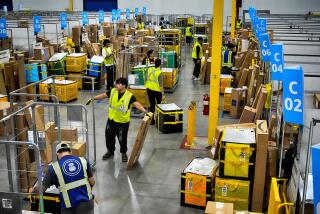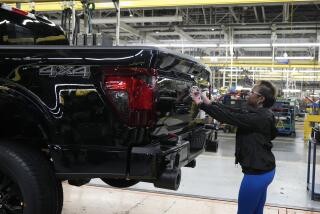Productivity in 2nd Quarter Is Best in 3 Years
WASHINGTON — The nation’s businesses scored a big gain in efficiency in the April-June period, allowing them to keep a lid on inflation and improve their profit margins, the government reported Tuesday.
The Labor Department said productivity among businesses other than farms rose at a sharp 2.7% annual rate in the second quarter, the largest quarterly gain in three years.
Last month, the department reported that productivity--the quantity of goods and services produced for each hour worked--had risen at only a 0.6% pace in the second quarter. But then the Commerce Department revised its gross domestic product figures for the quarter significantly upward, which caused productivity to jump also. In the meantime, the number of hours worked had been revised downward, further increasing the size of the productivity gain.
Meanwhile, hourly compensation, which includes both wages and employers’ costs of providing fringe benefits, rose at a 3.2% annual rate in the spring quarter. But the 2.7% rate of increase in productivity offset most of that. The result was that the cost of labor in each unit of output went up at only a 0.5% rate.
It was the slowest increase in three years and should help reassure the Federal Reserve Board that wage pressures aren’t building even though the nation’s unemployment rate, at 4.9%, is hovering just above a 24-year low.
“There’s no sign of any intensification of labor cost pressures,” said economist Stuart G. Hoffman of PNC Bank Corp. in Pittsburgh. “That’s considerably better than in the prior two quarters.”
Historically, these so-called unit labor costs have tended to track changes in consumer prices, and analysts said the latest reading suggests that rising wages aren’t putting much pressure on firms to raise their prices.
That appears to be true even if the numbers are looked at over a longer period. For instance, for the four quarters ended in June, nonfarm business productivity rose a more modest 1.2% while hourly compensation increased 3.5%. That left unit labor costs rising 2.2%, exactly in line with the increase in consumer prices over the period. (The numbers don’t add up precisely, due to rounding.)
Many analysts and policymakers, including Fed Chairman Alan Greenspan, question the accuracy of the productivity numbers, believing them to be understated substantially because of statisticians’ inability to measure output properly in some sectors, such as financial and medical services.
On Friday, Greenspan warned that the central bank must “remain on alert” to the possibility that tight labor markets will ripple into higher product prices.
But he also said it is “difficult to avoid the conclusion” that productivity has been advancing at a much healthier rate than shown by government statistics.
If that’s true, it means corporations can pay higher wages and earn strong profits without increasing their prices. And it implies the central bank doesn’t have to cool the economy with higher interest rates in order to contain inflation.
“The Fed has got to be happy with the numbers. They help explain why inflation has been benign and give it something to justify leaving interest rates unchanged,” said economist Hugh A. Johnson of First Albany Corp.
Productivity
Nonfarm business productivity, percentage change from previous quarter at annualized rate, seasonally adjusted:
1997: +2.7%
Source: Labor Department
More to Read
Inside the business of entertainment
The Wide Shot brings you news, analysis and insights on everything from streaming wars to production — and what it all means for the future.
You may occasionally receive promotional content from the Los Angeles Times.










